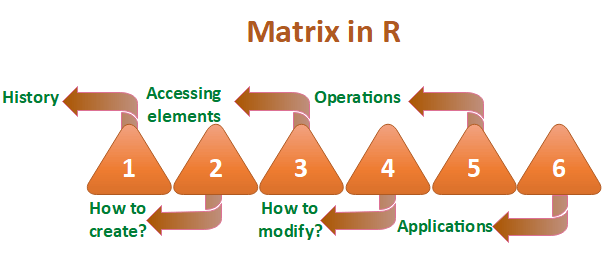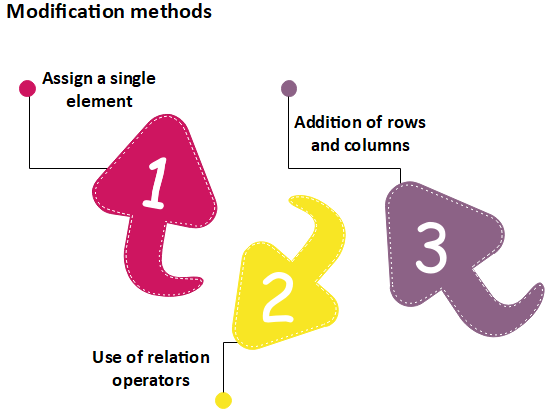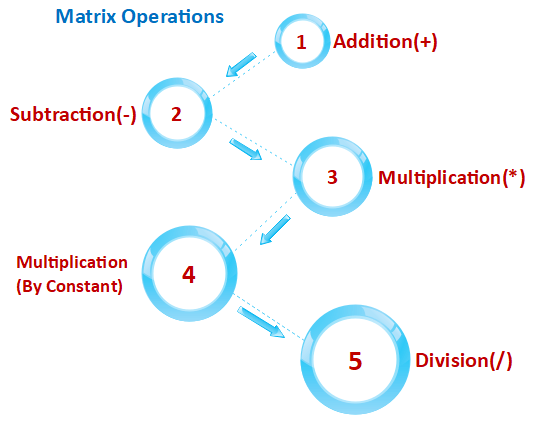R MatrixIn R, a two-dimensional rectangular data set is known as a matrix. A matrix is created with the help of the vector input to the matrix function. On R matrices, we can perform addition, subtraction, multiplication, and division operation. In the R matrix, elements are arranged in a fixed number of rows and columns. The matrix elements are the real numbers. In R, we use matrix function, which can easily reproduce the memory representation of the matrix. In the R matrix, all the elements must share a common basic type. ExampleOutput [,1] [,2] [,3] [1,] 11 13 15 [2,] 12 14 16 
History of matrices in RThe word "Matrix" is the Latin word for womb which means a place where something is formed or produced. Two authors of historical importance have used the word "Matrix" for unusual ways. They proposed this axiom as a means to reduce any function to one of the lower types so that at the "bottom" (0order) the function is identical to its extension. Any possible function other than a matrix from the matrix holds true with the help of the process of generalization. It will be true only when the proposition (which asserts function in question) is true. It will hold true for all or one of the value of argument only when the other argument is undetermined. How to create a matrix in R?Like vector and list, R provides a function which creates a matrix. R provides the matrix() function to create a matrix. This function plays an important role in data analysis. There is the following syntax of the matrix in R: data The first argument in matrix function is data. It is the input vector which is the data elements of the matrix. nrow The second argument is the number of rows which we want to create in the matrix. ncol The third argument is the number of columns which we want to create in the matrix. byrow The byrow parameter is a logical clue. If its value is true, then the input vector elements are arranged by row. dim_name The dim_name parameter is the name assigned to the rows and columns. Let's see an example to understand how matrix function is used to create a matrix and arrange the elements sequentially by row or column. Example Output
[,1] [,2] [,3]
[1,] 5 6 7
[2,] 8 9 10
[3,] 11 12 13
[4,] 14 15 16
[,1] [,2] [,3]
[1,] 3 7 11
[2,] 4 8 12
[3,] 5 9 13
[4,] 6 10 14
col1 col2 col3
row1 3 4 5
row2 6 7 8
row3 9 10 11
row4 12 13 14
Accessing matrix elements in RLike C and C++, we can easily access the elements of our matrix by using the index of the element. There are three ways to access the elements from the matrix.
Let see an example to understand how elements are accessed from the matrix present on nth row mth column, nth row, or mth column. Example Output
col1 col2 col3
row1 5 6 7
row2 8 9 10
row3 11 12 13
row4 14 15 16
[1] 12
col1 col2 col3
11 12 13
row1 row2 row3 row4
6 9 12 15
Modification of the matrixR allows us to do modification in the matrix. There are several methods to do modification in the matrix, which are as follows: 
Assign a single elementIn matrix modification, the first method is to assign a single element to the matrix at a particular position. By assigning a new value to that position, the old value will get replaced with the new one. This modification technique is quite simple to perform matrix modification. The basic syntax for it is as follows: Here, n and m are the rows and columns of the element, respectively. And, y is the value which we assign to modify our matrix. Let see an example to understand how modification will be done: Example Output
col1 col2 col3
row1 5 6 7
row2 8 9 10
row3 11 12 13
row4 14 15 16
col1 col2 col3
row1 5 6 7
row2 8 9 10
row3 11 20 13
row4 14 15 16
Use of Relational OperatorR provides another way to perform matrix medication. In this method, we used some relational operators like >, <, ==. Like the first method, the second method is quite simple to use. Let see an example to understand how this method modifies the matrix. Example 1 Output
col1 col2 col3
row1 5 6 7
row2 8 9 10
row3 11 12 13
row4 14 15 16
col1 col2 col3
row1 5 6 7
row2 8 9 10
row3 11 0 13
row4 14 15 16
Example 2 Output
col1 col2 col3
row1 5 6 7
row2 8 9 10
row3 11 12 13
row4 14 15 16
col1 col2 col3
row1 5 6 7
row2 8 9 10
row3 11 12 0
row4 0 0 0
Addition of Rows and ColumnsThe third method of matrix modification is through the addition of rows and columns using the cbind() and rbind() function. The cbind() and rbind() function are used to add a column and a row respectively. Let see an example to understand the working of cbind() and rbind() functions. Example 1 Output
col1 col2 col3
row1 5 6 7
row2 8 9 10
row3 11 12 13
row4 14 15 16
col1 col2 col3
row1 5 6 7
row2 8 9 10
row3 11 12 13
row4 14 15 16
17 18 19
col1 col2 col3
row1 5 6 7 17
row2 8 9 10 18
row3 11 12 13 19
row4 14 15 16 20
row1 row2 row3 row4
col1 5 8 11 14
col2 6 9 12 15
col3 7 10 13 16
[,1] [,2] [,3] [,4] [,5] [,6] [,7] [,8] [,9] [,10] [,11] [,12]
[1,] 5 8 11 14 6 9 12 15 7 10 13 16
Matrix operationsIn R, we can perform the mathematical operations on a matrix such as addition, subtraction, multiplication, etc. For performing the mathematical operation on the matrix, it is required that both the matrix should have the same dimensions. 
Let see an example to understand how mathematical operations are performed on the matrix. Example 1 Output
[,1] [,2] [,3]
[1,] 6 14 22
[2,] 8 16 24
[3,] 10 18 26
[4,] 12 20 28
[,1] [,2] [,3]
[1,] 4 4 4
[2,] 4 4 4
[3,] 4 4 4
[4,] 4 4 4
[,1] [,2] [,3]
[1,] 5 45 117
[2,] 12 60 140
[3,] 21 77 165
[4,] 32 96 192
[,1] [,2] [,3]
[1,] 60 108 156
[2,] 72 120 168
[3,] 84 132 180
[4,] 96 144 192
[,1] [,2] [,3]
[1,] 5.000000 1.800000 1.444444
[2,] 3.000000 1.666667 1.400000
[3,] 2.333333 1.571429 1.363636
[4,] 2.000000 1.500000 1.333333
Applications of matrix
Next TopicR Data Frame
|
 For Videos Join Our Youtube Channel: Join Now
For Videos Join Our Youtube Channel: Join Now
Feedback
- Send your Feedback to [email protected]
Help Others, Please Share










